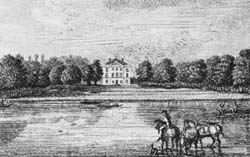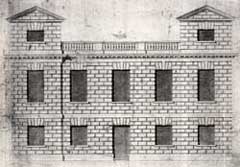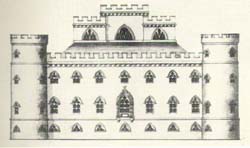Roger Morris
An architectural career founded on speculative building
1695 - 1749

Supervisory work at Marble Hill House
Roger Morris was associated with Colen Campbell and Henry Herbert, Earl of Pembroke. The latter was instrumental in securing his services for the construction of Marble Hill House between 1724 and 1729. Colen Campbell illustrated the house in a later edition of Vitruvius Britannicus.
A design at Whitton Place
In 1732 he was engaged by the Earl of Ilay, later the 3rd Duke of Argyll, to design a house at Whitton (known as Whitton Place and demolished in 1847). Ilay had also been involved with the land acquisition to enable the construction of Marble Hill House for Henrietta Howard.

A Palladian Villa
Morris bought some land in Cross Deep, Twickenham, just upstream of Pope's Villa and designed a little Palladian style villa there together with a tunnel beneath the road to land on the other side. He may not have lived to build and enjoy this, dying in 1749 and the property was bought by Thomas Hudson in 1753. The tunnel still exists, although it is inaccessible, but the villa was bought and demolished by Baroness Howe in about 1810.

In Gothic mode
There was a Gothic style villa on the land across the road, also demolished by the Baroness, known as Mr Hudson's Gothic House. Morris, or even Batty Langley may have designed this. Morris was at that time in Gothic mode following his work at Inverary Castle in Argyllshire for the Duke. Clearwell Castle in Gloucestershire was an earlier essay in the Gothic, designed for Thomas Wyndham in 1728.

After 1747 no promoter of Gothic design was on safe ground so near to Horace Walpole at Strawberry Hill, as both John Robartes, Earl of Radnor (at Radnor House) and Batty Langley found. Batty Langley was rash enough to invent a whole new system of Gothic design, incorporating five new Orders. However, Walpole admired Hudson and there is no record that he criticised his Gothic House.
Family connections
Morris married, first, Mary Jackson whose mother, also Mary, married to Sir Peter Jackson of Richmond was the daughter of Sir Peter Vandeput Sr. It was a family tradition that Lady Jackson's first child was born on the same day as her mother's (Lady Vandeput) twenty-second.
Roger Morris was held to have been the “kinsman” of Robert Morris of Twickenham whose father, Thomas was a London joiner. The relationship is not clear, though Roger did have an elder brother, Thomas and this was also his father's Christian name.
Further reading:
Howard Colvin, A Biographical Dictionary of British Architects 1600-1840, Yale, 1995
Anthony Beckles Willson. Mr Pope & Others at Cross Deep in the 18th Century, 1996
Ellen G Miles, Thomas Hudson 1701-1779, Greater London Council, 1979




